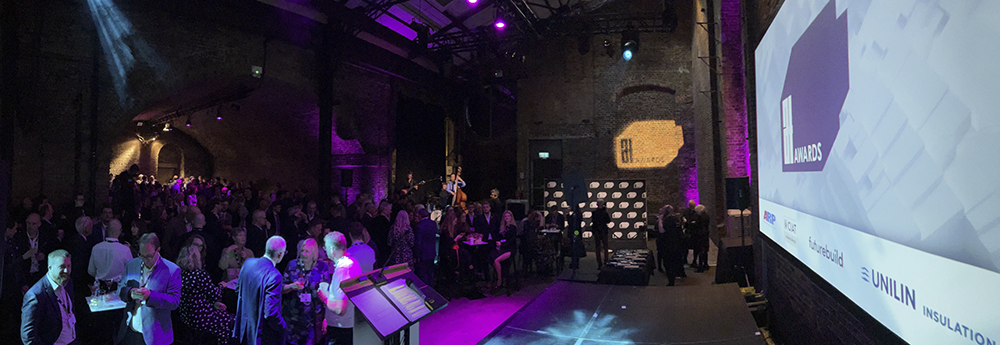The Architectural Technology Awards
Contents |
[edit] A brief introduction to the AT Awards
The AT Awards are CIAT’s premier accolades that demonstrate and recognise outstanding achievement – celebrating Architectural Technology at its best. They are designed to recognise excellence in Architectural Technology globally. The suite of AT Awards are open to all professionals and students; nationally and internationally.
Assessment is based upon the innovative application of Architectural Technology against a set criteria for each Award. Judges look for robust and functional designs that are:
- constructed economically;
- environmentally sustainable;
- and of durable performance.
[edit] AT Awards 2025
The Architectural Technology Awards (AT Awards) 2025 are now open for entries. They recognise the people and projects that demonstrate excellence in Architectural Technology. Entries are open to any organisation or individual, both within the UK and internationally, that practise Architectural Technology.
Find out more here : https://architecturaltechnology.com/at-awards.html
[edit] A brief introduction to the CIAT
On 12 February 1965, the Institute was founded and on 12 Februray 2025 it celebrates its 60th birthday, a time to reflect and look forward on the remarkable journey that both CIAT and Architectural Technology has had over six decades.
The Chartered Institute of Architectural Technologists (CIAT) describes itself as ‘…the lead qualifying body for Architectural Technology and represents those practising and studying within the discipline.’
The Chartered Institute of Architectural Technologists (CIAT) is the global membership qualifying body for Chartered Architectural Technologists. It represents those practising and studying within the discipline and profession of Architectural Technology, and qualifies Chartered Architectural Technologists, MCIAT, a regulated profession and protected title under Royal Charter.
Fellow Membership, FCIAT , which may also only be awarded by CIAT, complements the 'Chartered Architectural Technologist' professional qualification and is an acknowledgement of a Chartered Member's significant contribution to and/or excellence in Architectural Technology.
The institute was originally founded as the Society of Architectural and Associated Technicians (SAAT) in 1965 following a report by the Royal Institute of British Architects (RIBA) which recommended the creation of an institute for technicians. In 1986, SAAT became the British Institute of Architectural Technicians (BIAT), then in 1994 the British Institute of Architectural Technologists. On receiving its Royal Charter in 2005 it became the Chartered Institute of Architectural Technologists (CIAT).
It is a membership organisation, funded by, owned by and operated on behalf of its members. It is governed by an Executive Board and Council, both of which are chaired by its president.
CIAT describes its objectives as:
- To promote, for the benefit of society, the science and practice of Architectural Technology.
- To facilitate the development and integration of technology into architecture and the wider construction industry to continually improve standards of service for the benefit of industry and of society.
- To uphold and advance the standards of education, competence, practice and conduct of members of the Institute thereby promoting the interests, standing and recognition of Chartered Members within the industry and the wider society.
[edit] List of previous AT award articles
- 2024
- 2023
- 2021
- AT Awards: 2021 winners
- 2020
- 2019
- 2018
- 2017
--CIAT
[edit] Related articles on Designing Buildings
Featured articles and news
The UK's Modern Industrial Strategy: A 10 year plan
Previous consultation criticism, current key elements and general support with some persisting reservations.
Building Safety Regulator reforms
New roles, new staff and a new fast track service pave the way for a single construction regulator.
Architectural Technologist CPDs and Communications
CIAT CPD… and how you can do it!
Cooling centres and cool spaces
Managing extreme heat in cities by directing the public to places for heat stress relief and water sources.
Winter gardens: A brief history and warm variations
Extending the season with glass in different forms and terms.
Restoring Great Yarmouth's Winter Gardens
Transforming one of the least sustainable constructions imaginable.
Construction Skills Mission Board launch sector drive
Newly formed government and industry collaboration set strategy for recruiting an additional 100,000 construction workers a year.
New Architects Code comes into effect in September 2025
ARB Architects Code of Conduct and Practice available with ongoing consultation regarding guidance.
Welsh Skills Body (Medr) launches ambitious plan
The new skills body brings together funding and regulation of tertiary education and research for the devolved nation.
Paul Gandy FCIOB announced as next CIOB President
Former Tilbury Douglas CEO takes helm.
UK Infrastructure: A 10 Year Strategy. In brief with reactions
With the National Infrastructure and Service Transformation Authority (NISTA).
Ebenezer Howard: inventor of the garden city. Book review.
The Grenfell Tower fire, eight years on
A time to pause and reflect as Dubai tower block fire reported just before anniversary.
Airtightness Topic Guide BSRIA TG 27/2025
Explaining the basics of airtightness, what it is, why it's important, when it's required and how it's carried out.
Construction contract awards hit lowest point of 2025
Plummeting for second consecutive month, intensifying concerns for housing and infrastructure goals.
Understanding Mental Health in the Built Environment 2025
Examining the state of mental health in construction, shedding light on levels of stress, anxiety and depression.

























